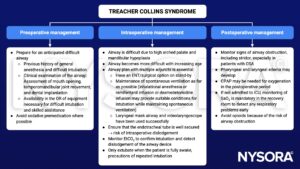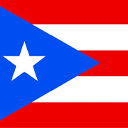Learning objectives
- Describe Treacher Collins syndrome
- Understand how Treacher Collins syndrome affects the airway
- Discuss the perioperative management of patients with Treacher Collins syndrome
Definition and mechanisms
- Treacher Collins syndrome (TCS) or mandibulofacial dysostosis is a rare autosomal dominant disorder of craniofacial development
- Congenital malformation of the first and second branchial arches, which may affect the size, shape, and position of the ears, eyelids, zygomatic (cheek) bones, and maxilla and mandible (jaws)
- TCS is characterized by hypoplasia of the facial bones, especially the zygoma and mandible
- It is bilateral, symmetrical, and restricted to the head and neck region
Signs and symptoms
Main features of TCS
- Malar hypoplasia and a cleft in the zygoma
- Eyes have an antimongloid slant with colobomas (eyelid notch) along the lateral ⅓ of the lower lid
- Lashes are absent from the medial ⅔ of the lower eyelid
- Face has a convex profile with a retrusive chin and jaw, associated with an overbite
- External ear abnormalities are common
- A cleft lip and/or palate is present in up to 35% of patients
| System affected | Features seen |
|---|---|
| Facial bones | Hypoplasia of the malar bones Underdeveloped zygoma Hypoplastic orbits Hypoplasia of maxilla, mandible, and temporomandibular joint |
| Eyes | Antimongloid slant of palpebrae Coloboma of the lower eyelid Hypoplasia of lower eyelids with partial absence of cilia Hypoplasia of lateral canthi Hypertelorism |
| Ears | Abnormality of the external ear Abnormality of the auditory canal Malformed middle ear ossicles Conductive hearing loss |
| Facial features | External nose deformity Deviated nasal septum Macrostomia with typical “fish-mouth” appearance “Bird-face” appearance Tongue-shaped hair process in the preauricular region |
| Intraoral features | Cleft palate Anterior open bite Steep occlusal plane Supernumerary teeth T-shaped teeth Enamel opacity/hypoplasia Microdontia, tooth agenesis Ectopic eruption/rotation of teeth |
| Other features | Choanal stenosis/atresia Occlusion of oropharynx and hypopharynx by the tongue Constricted nasal passages Obstructive sleep apnea |
Causes
- De-novo mutation (60%) or inherited (40%)
- Mutations in TCOF1, POLR1B, POLR1C, or POLR1D genes
Complications
- Facial abnormalities can result in airway narrowing and respiratory compromise
- Feeding difficulties
- Vision problems
- Hearing loss
- Obstructive sleep apnea (OSA)
Treatment
- Patients may require prone positioning or surgery to maintain a patent airway (e.g., tracheostomy)
- Patients may require a gastrostomy to ensure adequate food intake while protecting the airway
- Reconstructive surgery
- Hearing aids
- Speech therapy
Management

Keep in mind
- Prepare for an anticipated difficult airway in all children with TCS
- Direct laryngoscopy may become more difficult with increasing age
Suggested reading
- Hosking J, Zoanetti D, Carlyle A, Anderson P, Costi D. Anesthesia for Treacher Collins syndrome: a review of airway management in 240 pediatric cases. Paediatr Anaesth. 2012;22(8):752-758.
- Goel L, Bennur SK, Jambhale S. Treacher-collins syndrome-a challenge for anaesthesiologists. Indian J Anaesth. 2009;53(4):496-500.
We would love to hear from you. If you should detect any errors, email us customerservice@nysora.com



